Turn on red
In the United States outside New York City, right turns are permitted on red (except for school buses and trucks carrying hazardous materials) unless there is a "No Turn on Red" or a "Right Turn Signal" light indicating the same and controlling the right turn.
A turn on red is a principle of law permitting vehicles at a traffic light showing a red signal to turn into the direction of traffic nearer to them (almost always after a complete stop) when the way is clear, without having to wait for a green signal. It is intended to allow traffic to resume moving, with minimal risk provided that proper caution is observed.
It is commonly known as a right turn on red (or simply right on red) in countries that drive on the right side of the road, or a left turn on red in countries which drive on the left side of the road.
North America
Right turns on red are permitted in many regions of North America. While Western states have allowed it for more than 50 years; eastern states amended their traffic laws to allow it in the 1970s as a fuel-saving measure in response to motor fuel shortages in 1973. The Energy Policy and Conservation Act of 1975 required in §362(c)(5) that in order for a state to receive federal assistance in developing mandated conservation programs, they must permit right turns on red lights.[2] All 50 states, the District of Columbia, Guam, and Puerto Rico have allowed right turns on red since 1978, except where prohibited by a sign or where right turns are controlled by dedicated traffic lights. (In June 1978, Maryland became the last state to allow right turns on red.[3] Right turns on red became legal in the District of Columbia in November 1978.[4]) The few exceptions include New York City,[5] where right turns on red are prohibited, unless a sign indicates otherwise.
In some states, such as New York,[6] North Carolina, and California, a right turn on red is prohibited when a red arrow is displayed.
At intersections where U-turns are permitted and controlled by a U-turn arrow from the left-most lane, motorists turning right on red onto the same road must yield to those making U-turns before turning, as the motorists making U-turns have the right of way and a collision could easily occur. At intersections where U-turns are prohibited in the same fashion, a green right turn arrow will sometimes appear with the red light for those turning right onto the road, allowing only traffic turning right to proceed without having to stop or yield to other vehicles. Some states such as California have "No U-Turn" signs posted at these intersections because of the green right turn arrow.
Most Caribbean countries with right-hand traffic, such as the Dominican Republic, allow right turn on red unless a sign prohibits it. Some vehicles, such as those carrying hazardous materials and school buses, are not allowed to turn on red under any circumstance and must wait for a green light or arrow.
During 1982–1992, approximately 84 fatal crashes per year occurred in the U.S. where a vehicle was turning right at intersections where right turn on red was permitted. As of 1992, right turn on red is governed federally by 42 U.S.C. § 6322(c) ("Each proposed State energy conservation plan to be eligible for Federal assistance under this part shall include: ...(5) a traffic law or regulation which, to the maximum extent practicable consistent with safety, permits the operator of a motor vehicle to turn such vehicle right at a red stop light after stopping, and to turn such vehicle left from a one-way street onto a one-way street at a red light after stopping."). All turns on red are forbidden in New York City unless a sign is posted permitting it.[7]
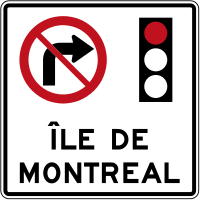
Through most of Canada, a driver may turn right at a red light after coming to a complete stop unless a sign indicates otherwise. In the province of Quebec, turning right on a red was illegal until a pilot study carried out in 2003 showed that the right turn on red manoeuvre did not result in significantly more accidents. Subsequent to the study, the Province of Quebec now allows right turns on red except where prohibited by a sign. However, like in New York City, it remains illegal to turn right on a red anywhere on the Island of Montreal.[8] Motorists are reminded of this by large signs posted at the entrance to all bridges.
In Mexico, right turns on red are generally allowed unless a sign indicates otherwise.[9] Mexico City has implemented a new transit law which prohibits right turns and motorists can be issued a citation for noncompliance.[10]
Central America
In Costa Rica, right turns on red are allowed in general, but a sign can forbid them.
South America
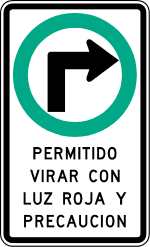
In Chile, right turns on red are only allowed when a sign permitting it is shown.
In Paraguay, right turns on red are allowed in some towns.
In Brazil, right turns on red are not allowed.
In Uruguay, right turns on red are not allowed.
In Peru, right turns on red are not allowed.
Europe

In the European Union member states in general, it is illegal to turn on a red light, unless it is indicated otherwise, for example by a green arrow on a red light, a flashing amber arrow with a red light or a permanent green board next to the red light.
In Poland, right turns on red are permitted, only if an additional green arrow light (apart from the main signal light) is present and flashing. However, the regulations require drivers to stop completely, as their paths intersect with other vehicles or pedestrians in at least one direction. Green arrow light can be also directed left (the same regulations apply).[11]
In Germany, right turns on red are only permitted, after a complete stop, when a specific sign is present. This rule was first introduced in 1978 in East Germany and was originally supposed to become obsolete together with the East German highway code by the end of 1990, following German reunification. However, authorities were unable to remove the signs in time, and public opinion caused them to leave the regulation unchanged, even extending its scope to the former areas of West Germany in 1994. By 1999, there were 300 turn-on-red intersections in West Germany while East Germany featured 2,500; the numbers in West Germany have risen considerably since then, though, and as of 2002 a total of 5,000 turn-on-red intersections were counted, with 48% in West Germany.
In Russia, turns on red are prohibited unless a separate arrow-shaped green light allows it; drivers must give way to any vehicle coming from a different direction. When the arrow is not lit, turns in the arrow direction are prohibited.[12]
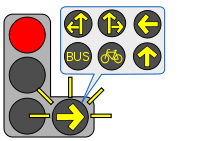
In the Netherlands, bicycles are occasionally allowed to turn right on a red light. Wherever this is the case, a sign "rechtsaf voor fietsers vrij" (right turn free for cyclists) or "rechtsaf voor (brom)fietsers vrij" (right turn free for cyclists and mopeds) is present.
In France a right turn on red without stopping is allowed when a separate arrow-shaped amber light flashes, but drivers do not have priority. They must check if any pedestrians are crossing before turning and must give way to vehicles coming from other directions.[13]. In France it is allowed to turn right on red for cyclists if a sign tell so.
In Belgium, road signs that allow cyclists to turn right on a red light have been added to traffic law in 2012.[14] Such roads signs have been placed on intersections in the Brussels Capital Region.[15]
Like in the Netherlands, Belgium and France have a road sign that allows cyclists to turn right on a red light. The French and Belgian signs consits in a yield sign with a yellow bike and arow inside. Such signs are placed under traffic lights.[16]
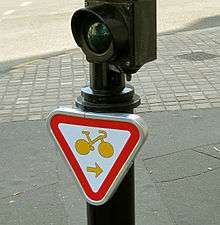
In the United Kingdom, which drives on the left, left turn on red is prohibited, but at some junctions there is a separate left arrow-shaped green "filter" light which, when lit, allows left-hand turns but conflicting traffic will always have a red signal.[17] Other non conflicting traffic movements may have their own left or right arrow-shaped green light. Sometimes there are specific lanes without signals for turning left, separated from the through traffic signalled traffic by traffic islands, but give way signs are installed.
In Lithuania, drivers are allowed to turn right on red when a specific sign with green arrow is present. However, on 10 November 2014, traffic rules were changed so that the specific sign with green arrow is valid until 31 December 2019. Until that time all specific signs with green arrows in Lithuania will be eliminated. Changes were made because of road safety reasons.[18]
In Czech republic and Slovakia right turns on red are allowed only when there is a lit green arrow present (called S 5 in Czech republic and S 10 in Slovakia). Also in this case the car turning on red must give way to ongoing traffic, to pedestrians and other road users. (According to Czech law §70 of decree 30/2001 of Law Codex; and Slovak law §9, part 3g, decree 9/2009 of Law Codex)
In Bulgaria right turns on red are prohibited.
In Spain, right turns on red are allowed only if there's either a flashing amber or lit green arrow-shaped traffic light. Flashing amber arrow allows turning without priority (turn must be done exercising caution, giving way to any other vehicles and pedestrians that may cross the path), while a lit green arrow grants priority. If just a regular set of traffic lights is present (no light arrows), then turning on red is prohibited.
Asia

As in the United Kingdom, left turn on red is always prohibited in Hong Kong. At some junctions, however, there may be separate sets of signals for left turns, or specific lanes for turning left separating from the through traffic by traffic islands and give way signs are installed. One such example is at the junction of Queen's Road East and Morrison Hill Road.
In China, right turn on red is permitted, unless there is a red arrow pointing to the right.
In India, which drives on the left, a "Free left turn" is generally not allowed. RED always implies STOP.[19][20][21] We mostly follow UK highway code and per highway code there is no "Free left turn".[22] But, some times certain cities allow "Free left turns".[23] Usually if there is any "left signal" it's considered as a free left turn when the signal is blinking orange(amber) or bright green. If there isn't any special left signal, it is generally considered as no free left. Free lefts are usually separated from the main road by a divider, they are also usually allowed if the opposite traffic cannot U-Turn into the lane that your trying to merge.[24] It is to be remembered that "free left" implies turning left by giving away to oncoming traffic.In chandigarh, left turn on red is allowed when there is no signal for left direction.[25]
In Japan, which drives on the left, the only left turn allowed requires a green left arrow along with the red light.
In Singapore, which drives on the left, left turn on red is allowed only when the "Left Turn On Red" sign is displayed at the traffic junction. The driver will have to stop at the red light first and give way to pedestrians and oncoming vehicles from their right before turning.[26]
In Taiwan (Republic of China), right turn on red is always prohibited, except when there is a green arrow along with the red light.
In Thailand, which drives on the left, left turn on red is allowed unless a sign prohibits it.
Oceania
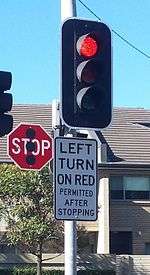
In Australia, which drives on the left, left turns on red are not permitted unless a sign indicating otherwise exists at the intersection. At such intersections, a sign generally reads "left turn on red permitted after stopping," meaning a vehicle can make a left turn only after coming to a complete stop first and giving way to approaching traffic and any crossing pedestrians or cyclists.[27][28]
Such signs are only in limited locations in the states of New South Wales, Queensland, South Australia as well as the Northern Territory and Australian Capital Territory and are banned in other states.[29] In South Australia, there were just 6 such intersections allowing turns on red in the entire state as of 2016.[30] There are conflicting views on the policy of left turns on red, with supporters pointing to lower vehicle emission and time savings, while opponents cite safety concerns.[30][31]
In New Zealand, which drives on the left, left turns on red are not permitted. However, some intersections have a special lane passing to the left of the traffic light that then joins on to the main road with a give way sign, effectively allowing a left turn on red.
Pedestrian safety
Turns on red are especially problematic for pedestrians due to drivers looking left for traffic on red light and not noticing a pedestrian waiting to cross the street to the driver's right. This may lead to a "right hook" collision when the driver and pedestrian both enter the intersection. Right on red reduces perceived safety for pedestrians and hence walkability. Suburbanization and car oriented development of the west has been a driving force behind right turn on red, although in some downtown core areas even in Western US right on red is explicitly prohibited with signs.
Left turn on red in countries with right hand traffic (turning across traffic)

|
Left turns on red from one-way and two-way streets into one-way streets permitted
Left turns on red from one-way streets into one-way streets permitted
State prohibits left turns on red
|
In the U.S., 36 states and Puerto Rico allow left turns on red only if both the origin and destination streets are one way. (See South Carolina law Section 56-5-970 C3,[32] for example.)
Five other states, namely Alaska, Idaho, Michigan, Oregon and Washington, allow left turns on red onto a one-way street even from a two-way street.[33][34][35][36][37]
The following states and territories ban left turns on red: South Dakota (unless permitted by local ordinance), Connecticut, Maine, Missouri, New Hampshire, New Jersey, North Carolina, Rhode Island, the District of Columbia, and Guam. New York City also prohibits left turn on red lights, unless a sign indicates otherwise.[38]
In Canada, left turn on red light from a one-way road into a one-way road is permitted except in some areas of Quebec, New Brunswick, and Prince Edward Island. Left turn on red light from a two-way road into a one-way road is permitted in British Columbia[39] but only if the driver turns onto the closest lane and yields to pedestrians and cross traffic.
See also
References
- ↑ "Driver's Manual" (PDF). New York State Department of Motor Vehicles.
- ↑ "Energy Policy and Conservation Act". govtrack.us.
- ↑ "Maryland To Adopt New Right Turn Rules". The Washington Post. June 22, 1978. p. MD6.
- ↑ Eisen, Jack (November 11, 1978). "Right Turn on Red: City Adopts Limited Program at Designated Intersections". The Washington Post. p. B1.
- ↑ "Right Turn on Red" (PDF). Sustainable Streets Index. New York City Department of Transportation. 2009.
- ↑ "Chapter 4: Traffic Control". Online Driver's Manual and Study Guide. New York State Department of Motor Vehicles.
- ↑ "Right Turn on Red" (PDF). nyc.com. Retrieved 22 January 2010.
- ↑ mtq.gouv.qc.ca
- ↑ Estado de Mexico
- ↑ "Adiós a la vuelta continua y multas por usar el teléfono, así el nuevo Reglamento de Tránsito del DF - Animal Político". Retrieved 28 October 2016.
- ↑ Rozporządzenie Ministrów Infrastruktury oraz Spraw Wewnętrznych i Administracji z dnia 31 lipca 2002 r. w sprawie znaków i sygnałów drogowych, § 96.1. and 96.3.
- ↑ Правила дорожного движения Российской Федерации, п.6.3
- ↑ Arrêté du 24 novembre 1967 relatif à la signalisation des routes et des autoroutes - Article 7 , Legifrance, accessdate=02 October 2015
- ↑ "Wet tot wijziging van artikel 6.3 van het koninklijk besluit van 1 december 1975 houdende algemeen reglement op de politie van het wegverkeer en van het gebruik van de openbare weg teneinde te voorzien in een afwijking op het algemene voorrangsbeginsel voor de verkeerslichten, in geval van verkeersborden die voorrang verlenen aan de fietsers".
- ↑ "Brussel plaatst 100 extra borden waar fietser door het rood mogen rijden". Het Laatste Nieuws. Retrieved 15 June 2015.
- ↑ Trotignon, Jean-Michel. "Tourne à droite au feu rouge: il manque juste le panneau" (PDF). Vélocité. Fédération française des Usagers de la Bicyclette. Retrieved 16 July 2011.
- ↑ "The Highway Code: Using the road (rule 177)". Retrieved 26 June 2015.
- ↑ Changes of Lithuanian Traffic rules on 3rd October 2014 - valid from 10th October 2014 (Lithuanian) http://www3.lrs.lt/pls/inter3/dokpaieska.showdoc_l?p_id=484529&p_tr2=2
- ↑ "Why are there no free-left turns in Bangalore? - Quora". www.quora.com. Retrieved 2016-11-04.
- ↑ Adhiraj Joglekar (2007-05-08), Driving in India: At Red Lights There are no Free Left Turns, retrieved 2016-11-04
- ↑ "Common Traffic Rules". India Study Channel. 2009-08-30. Retrieved 2016-11-04.
- ↑ "Light signals controlling traffic - The Highway Code - Guidance - GOV.UK". www.gov.uk. Retrieved 2016-11-04.
- ↑ Ramu, Marri (2015-12-26). "For a change, it's a hassle-free ride". The Hindu. ISSN 0971-751X. Retrieved 2016-11-05.
- ↑ "Did govt change the "No Free Left" Rule, off late - Team-BHP". Team-BHP.com. Retrieved 2016-11-05.
- ↑ "Chandigarh traffic police, promoting road safety, traffic safety, India road signs & rules, safe responsible driving, first aid India.". www.chandigarhtrafficpolice.org. Retrieved 2016-11-05.
- ↑ Left Turn On Red Scheme, Singapore ONE Motoring, Land Transport Authority Singapore 2011-08-27
- ↑ "Traffic lights and road markings - Safety & Rules". Roads and Maritime Services. Archived from the original on 14 October 2016. Retrieved 14 October 2016.
- ↑ "Left Turn on Red project". Brisbane City Council. Archived from the original on 14 October 2016. Retrieved 14 October 2016.
- ↑ Fuller, Peta (19 October 2013). "Left turns at red lights to be allowed in new traffic trial". news.com.au. Retrieved 14 October 2016.
- 1 2 "Call to allow left-hand turns on red lights in SA". ABC News. 24 July 2016. Retrieved 14 October 2016.
- ↑ Acott, Kent (27 April 2014). "Turn left on red possible solution". The West Australian. Retrieved 14 October 2016.
- ↑ "South Carolina Code of Laws (Unannotated): Current through the end of the 2010 Session". South Carolina Legislature Online. Office of Legislative Printing, Information & Technology Systems. November 5, 2011. Archived from the original on November 5, 2011.
S.C. Code Section 56-5-970(C)(3). Except when a sign is in place prohibiting a turn, vehicular traffic facing any steady red signal may cautiously enter the intersection to turn right or to turn left from a one-way street into a one-way street after stopping as required by item (1) or (2). Such vehicular traffic shall yield the right-of-way to pedestrians lawfully within an adjacent crosswalk and to other traffic lawfully using the intersection.
- ↑ "DOC Frame Page". Legis.state.ak.us. Retrieved 2016-10-28.
- ↑
- ↑ Offices, Legislative. "Idaho State Legislature". Retrieved 28 October 2016.
- ↑ "Michigan Legislature - Section 257.612". Retrieved 28 October 2016.
- ↑ "RCW 46.61.055: Traffic control signal legend.". Retrieved 28 October 2016.
- ↑ "The place in New York City where you can turn left on red". Retrieved 28 October 2016.
- ↑ BC Motor Vehicle Act, Section 129
External links
- The Safety Impact Of Right Turn On Red: Report To Congress, National Highway Traffic Safety Administration Traffic Tech
- Sarkar, van Houten, and Moffatt, Using License Manuals To Increase Awareness About Pedestrian Hazards at Intersections, Transportation Research Record 1674.
- Traffic Light Signals and Red Light Cameras: Turning on Red Light (US), by Justin JIH.